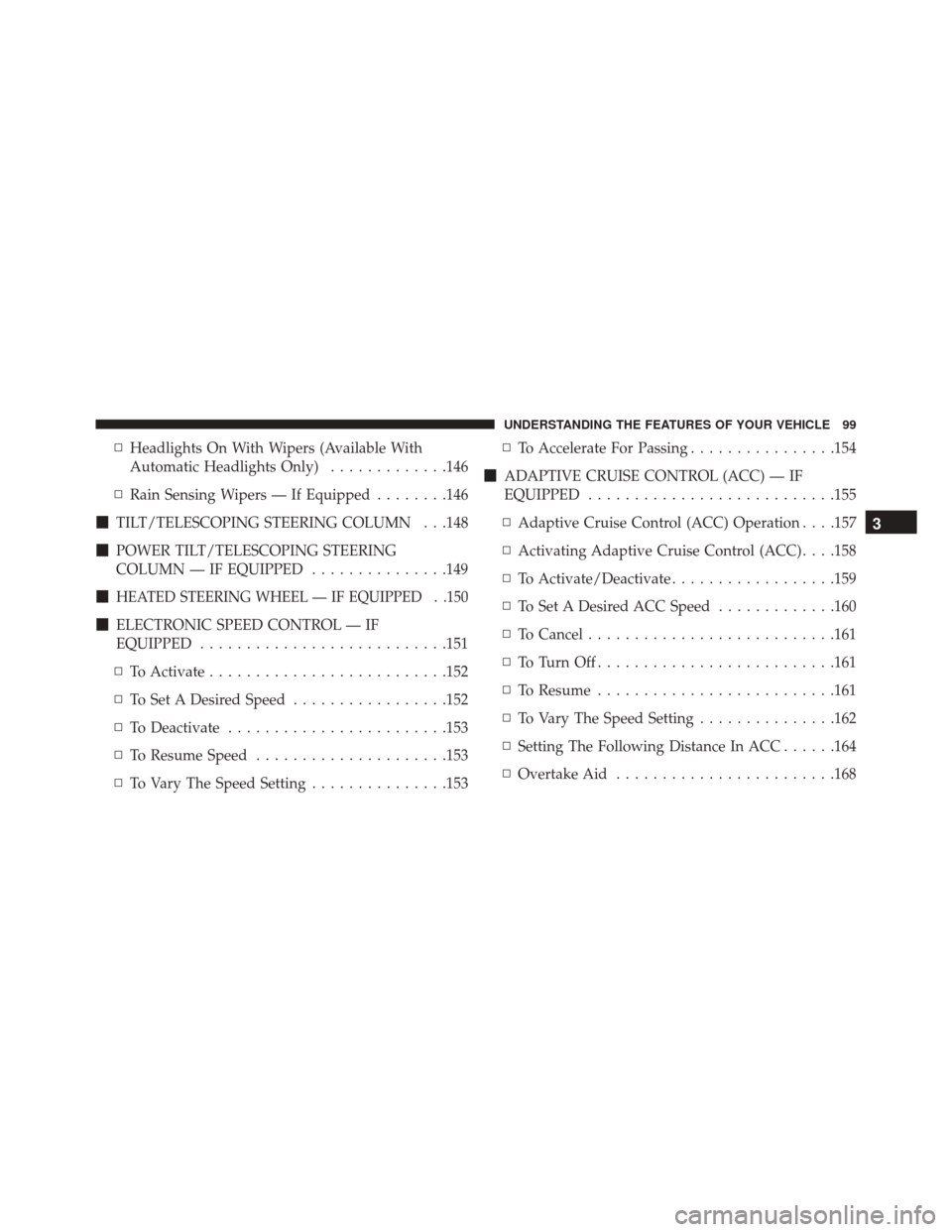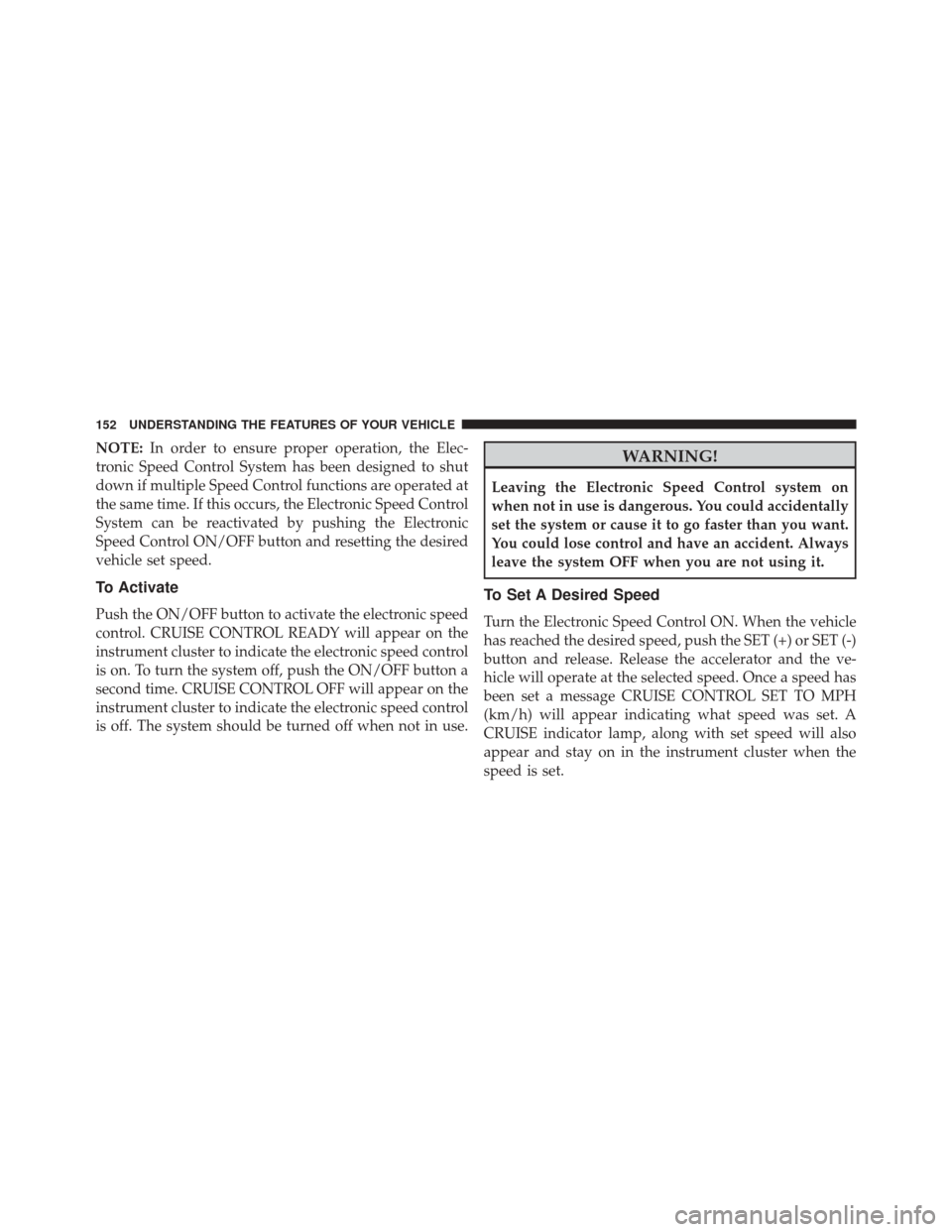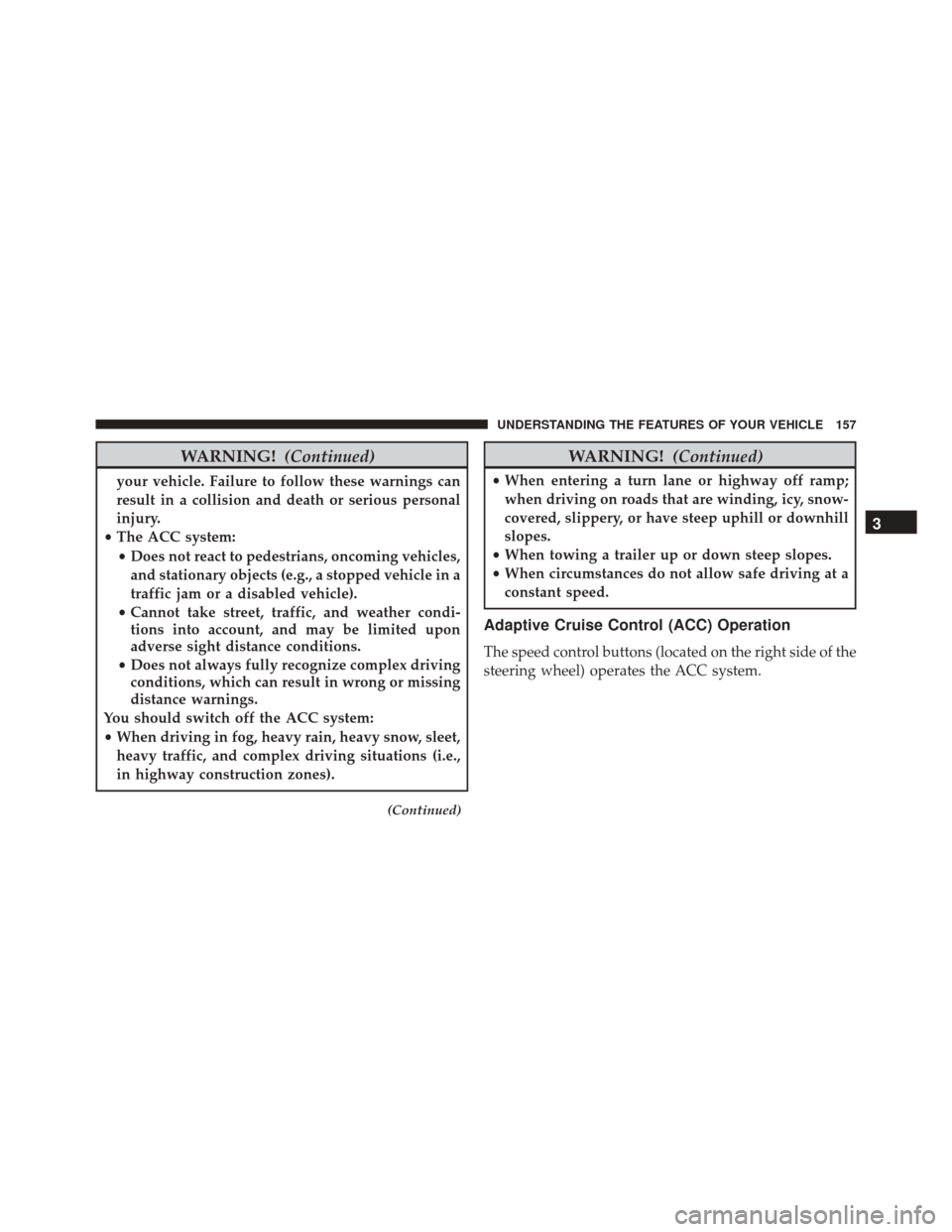Page 101 of 575

▫Headlights On With Wipers (Available With
Automatic Headlights Only) .............146
▫ Rain Sensing Wipers — If Equipped ........146
� TILT/TELESCOPING STEERING COLUMN . . .148
� POWER TILT/TELESCOPING STEERING
COLUMN — IF EQUIPPED ...............149
�
HEATED STEERING WHEEL — IF EQUIPPED . .150
� ELECTRONIC SPEED CONTROL — IF
EQUIPPED .......................... .151
▫ To Activate ......................... .152
▫ To Set A Desired Speed .................152
▫ To Deactivate ....................... .153
▫ To Resume Speed .....................153
▫ To Vary The Speed Setting ...............153 ▫
To Accelerate For Passing ................154
� ADAPTIVE CRUISE CONTROL (ACC) — IF
EQUIPPED .......................... .155
▫ Adaptive Cruise Control (ACC) Operation . . . .157
▫ Activating Adaptive Cruise Control (ACC) . . . .158
▫ To Activate/Deactivate ..................159
▫ To Set A Desired ACC Speed .............160
▫ To Cancel .......................... .161
▫ ToTurnOff......................... .161
▫ To Resume ......................... .161
▫ To Vary The Speed Setting ...............162
▫ Setting The Following Distance In ACC ......164
▫ Overtake Aid ....................... .168
3
UNDERSTANDING THE FEATURES OF YOUR VEHICLE 99
Page 102 of 575

▫Adaptive Cruise Control (ACC) Menu .......168
▫ Display Warnings And Maintenance ........169
▫ Precautions While Driving With ACC .......171
▫ General Information ....................175
▫ Normal (Fixed Speed) Electronic Speed Control
Mode ............................. .176
� FORWARD COLLISION WARNING (FCW) — IF
EQUIPPED .......................... .180
▫
Forward Collision Warning (FCW) Operation . . .180
▫ Turning FCW ON Or OFF ...............181
▫ Changing FCW Status ..................182
▫ Service FCW Warning ..................183
� PARKSENSE® REAR PARK ASSIST — IF
EQUIPPED .......................... .183▫
ParkSense® Sensors ....................183
▫ ParkSense® Warning Display .............184
▫ ParkSense® Display ....................184
▫ Enabling And Disabling ParkSense® ........188
▫ Service The ParkSense® Rear Park Assist
System ............................ .189
▫ Cleaning The ParkSense® System ..........190
▫ ParkSense® System Usage Precautions .......190
� PARKVIEW® REAR BACK UP CAMERA — IF
EQUIPPED .......................... .192
� OVERHEAD CONSOLE ..................194
▫ Courtesy/Reading Lights ...............195
▫ Sunglasses Storage ....................195
� GARAGE DOOR OPENER — IF EQUIPPED . . .195
100 UNDERSTANDING THE FEATURES OF YOUR VEHICLE
Page 154 of 575

NOTE:In order to ensure proper operation, the Elec-
tronic Speed Control System has been designed to shut
down if multiple Speed Control functions are operated at
the same time. If this occurs, the Electronic Speed Control
System can be reactivated by pushing the Electronic
Speed Control ON/OFF button and resetting the desired
vehicle set speed.
To Activate
Push the ON/OFF button to activate the electronic speed
control. CRUISE CONTROL READY will appear on the
instrument cluster to indicate the electronic speed control
is on. To turn the system off, push the ON/OFF button a
second time. CRUISE CONTROL OFF will appear on the
instrument cluster to indicate the electronic speed control
is off. The system should be turned off when not in use.
WARNING!
Leaving the Electronic Speed Control system on
when not in use is dangerous. You could accidentally
set the system or cause it to go faster than you want.
You could lose control and have an accident. Always
leave the system OFF when you are not using it.
To Set A Desired Speed
Turn the Electronic Speed Control ON. When the vehicle
has reached the desired speed, push the SET (+) or SET (-)
button and release. Release the accelerator and the ve-
hicle will operate at the selected speed. Once a speed has
been set a message CRUISE CONTROL SET TO MPH
(km/h) will appear indicating what speed was set. A
CRUISE indicator lamp, along with set speed will also
appear and stay on in the instrument cluster when the
speed is set.
152 UNDERSTANDING THE FEATURES OF YOUR VEHICLE
Page 157 of 575

NOTE:The Electronic Speed Control system maintains
speed up and down hills. A slight speed change on
moderate hills is normal.
On steep hills, a greater speed loss or gain may occur so
it may be preferable to drive without Electronic Speed
Control.
WARNING!
Electronic Speed Control can be dangerous where the
system cannot maintain a constant speed. Your ve-
hicle could go too fast for the conditions, and you
could lose control and have an accident. Do not use
Electronic Speed Control in heavy traffic or on roads
that are winding, icy, snow-covered or slippery.
ADAPTIVE CRUISE CONTROL (ACC) — IF
EQUIPPED
Adaptive Cruise Control (ACC) increases the driving
convenience provided by cruise control while traveling
on highways and major roadways. However, it is not a
safety system and not designed to prevent collisions.
Electronic Speed Control function performs differently.
Please refer to the proper section within this chapter.
ACC will allow you to keep cruise control engaged in
light to moderate traffic conditions without the constant
need to reset your cruise control. ACC utilizes a radar
sensor designed to detect a vehicle directly ahead of you.
3
UNDERSTANDING THE FEATURES OF YOUR VEHICLE 155
Page 158 of 575

NOTE:
•If the sensor does not detect a vehicle ahead of you,
ACC will maintain a fixed set speed.
• If the ACC sensor detects a vehicle ahead, ACC will
apply limited braking or acceleration (not to exceed
the original set speed) automatically to maintain a
preset following distance, while matching the speed of
the vehicle ahead.
The Cruise Control system has two control modes:
• Adaptive Cruise Control mode for maintaining an
appropriate distance between vehicles.
• Normal (fixed speed) cruise control mode is for cruis-
ing at a constant preset speed. For additional informa-
tion, refer to “Normal (Fixed Speed) Cruise Control
Mode” in this section. NOTE:
The normal (fixed speed) cruise control will not
react to preceding vehicles. Always be aware of the mode
selected.
You can change the mode by using the Cruise Control
buttons. The two control modes function differently.
Always confirm which mode is selected.
WARNING!
• Adaptive Cruise Control (ACC) is a convenience
system. It is not a substitute for active driving
involvement. It is always the driver ’s responsibil-
ity to be attentive of road, traffic, and weather
conditions, vehicle speed, distance to the vehicle
ahead; and, most importantly, brake operation to
ensure safe operation of the vehicle under all road
conditions. Your complete attention is always re-
quired while driving to maintain safe control of
(Continued)
156 UNDERSTANDING THE FEATURES OF YOUR VEHICLE
Page 159 of 575

WARNING!(Continued)
your vehicle. Failure to follow these warnings can
result in a collision and death or serious personal
injury.
• The ACC system:
• Does not react to pedestrians, oncoming vehicles,
and stationary objects (e.g., a stopped vehicle in a
traffic jam or a disabled vehicle).
• Cannot take street, traffic, and weather condi-
tions into account, and may be limited upon
adverse sight distance conditions.
• Does not always fully recognize complex driving
conditions, which can result in wrong or missing
distance warnings.
You should switch off the ACC system:
• When driving in fog, heavy rain, heavy snow, sleet,
heavy traffic, and complex driving situations (i.e.,
in highway construction zones).
(Continued)
WARNING! (Continued)
•When entering a turn lane or highway off ramp;
when driving on roads that are winding, icy, snow-
covered, slippery, or have steep uphill or downhill
slopes.
• When towing a trailer up or down steep slopes.
• When circumstances do not allow safe driving at a
constant speed.
Adaptive Cruise Control (ACC) Operation
The speed control buttons (located on the right side of the
steering wheel) operates the ACC system.
3
UNDERSTANDING THE FEATURES OF YOUR VEHICLE 157
Page 160 of 575
NOTE:Any chassis/suspension or tire size modifications
to the vehicle will effect the performance of the Adaptive
Cruise Control and Forward Collision Warning System.
Activating Adaptive Cruise Control (ACC)
You can only engage ACC if the vehicle speed is above
20 mph (32 km/h).
The system will cancel when the vehicle speed drops
below 15 mph (24 km/h).
The minimum Set Speed for the ACC system is 20 mph
(32 km/h).
When the system is turned on and in the READY state,
the Driver Information Display (DID) displays “ACC
Ready.”
When the system is OFF, the DID displays “Adaptive
Cruise Control (ACC) Off.”
Adaptive Cruise Control Buttons1 — NORMAL (FIXED SPEED) CRUISE CONTROL ON/OFF
2 — SET+/ACCEL
3 — RESUME
4 — SET-/DECEL
5 — DISTANCE SETTING — INCREASE
6 — ADAPTIVE CRUISE CONTROL (ACC) ON/OFF
7 — DISTANCE SETTING — DECREASE
8 — CANCEL
158 UNDERSTANDING THE FEATURES OF YOUR VEHICLE
Page 161 of 575
NOTE:You cannot engage ACC under the following
conditions:
• When you apply the brakes.
• When the parking brake is set.
• When the automatic transmission is in PARK, RE-
VERSE or NEUTRAL.
• When the Vehicle speed is outside of the speed range.
• When the brakes are overheated.
• When the ESC is in Full-off mode.
To Activate/Deactivate
Push and release the Adaptive Cruise Control (ACC)
ON/OFF button. The ACC menu in the DID displays
“ACC Ready.” To turn the system OFF, push and release the Adaptive
Cruise Control (ACC) ON/OFF button again. At this
time, the system will turn off and the DID will display
“Adaptive Cruise Control (ACC) Off.”
Adaptive Cruise Control Ready
3
UNDERSTANDING THE FEATURES OF YOUR VEHICLE 159